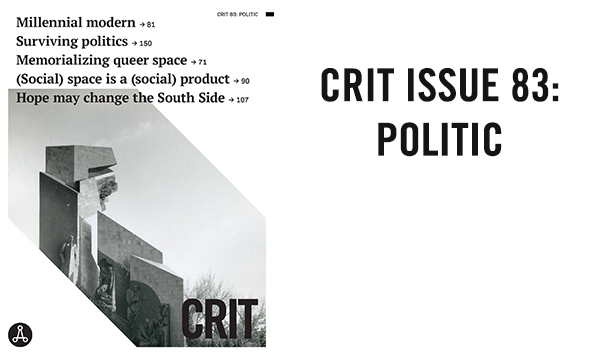The AIAS is excited to announce the publication of the next issue of CRIT Journal, No. 83. This year’s Editor-in-Chief, Cyrus Dahmubed, invites you to take a look at the rethought and redesigned journal, in conjunction with the newly appointed Design Editor, Kirk Newton.
To my fellow students,
I am pleased to welcome you to the brand new, rethought and redesigned CRIT. Over the remainder of the year, we will continue to build on this iteration of CRIT as a platform for high-quality student scholarship, meaningful and impactful design, and a clear and effective conveyor of AIAS resources and programs.
Appropriately, we have been guided in the reinvention of this publication by a study of the words we use to define the AIAS. We must reaffirm what it means to be the American Institute of Architecture Students: to preserve our American values, to bolster the value of our institutes, to understand the contributions that architecture can make and the problems it can solve, and to recognize that our role as students is as thinkers, listeners, and facilitators of beneficial discourse. In pursuit of these goals, we have brought a new curatorial lens to CRIT and selected for this issue’s theme the term “politic”, defined as “seeming sensible and judicious under the circumstances; prudent and sagacious”. We identified in this the notions of centering and balance, and from this a recognition that our culture and indeed our politics are increasingly polemicized. What part does design play in moderating this dynamic?
Designers work by choosing which narratives to express and which arguments to make, positioning us well to recognize the merits of many perspectives and select from them the ones that best meet the needs of the context. This objectivity breeds civility and nuance; in a world of growing polarity what we lack is the politic. Though rooted in the Greek notion of the polis – a city made up of people, each of whom had a voice worthy of being respected – our politics today seem rooted more in the Latin polus: the opposing ends of an axis. What does it mean to be an architect in this age? Are architectural practice and pedagogy adapting to a polarized world by becoming polarized themselves? Does work that stakes a claim deny the validity of every other perspective, or can it, instead, serve as an equalizing platform for all voices? What does an architecture of ideological equality look like?
Our writers have considered our borders, cities, monuments, educations, and practice through the lenses of equity, responsibility, and reflection to derive how our profession and our discourse can bring the politic, not the polemic, back to our society.
Thank you and welcome to CRIT,
Cyrus Dahmubed, Assoc. AIA | Editor in Chief
We invite you to take a look at the newest issue!
CRIT Issue 83










